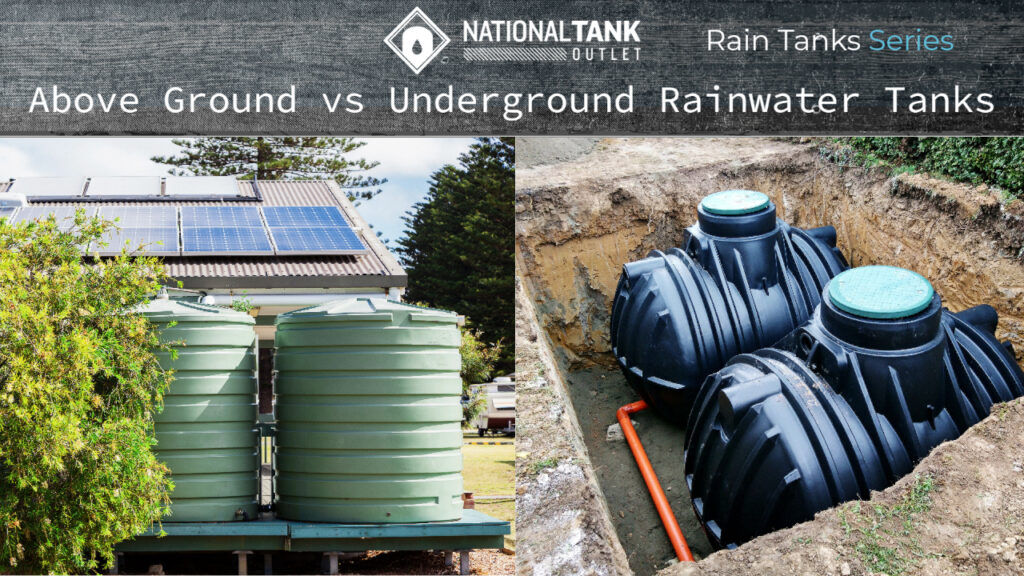
In the practice of rainwater harvesting, there are multiple types of collection containers good to use but only two main locations for a container to be positioned and installed: above ground or underground. There are advantages and disadvantages to each location as well as selective features available to each type of tank. Whenever planning a rainwater harvesting system, it helps to know the options as well as the pros and cons of above ground versus underground rainwater tanks.
In this Rain Tanks Series post, we will lay out a point-by-point overview of the benefits, challenges, and overall considerations for both above ground and underground installation of a rainwater harvesting tank.
First, we will look at tank types for above ground rainwater tanks. Tank type is used to mean the engineered style of the storage container as well as the material it is made from.
Tank Types: Above Ground Rainwater Tanks
Compared to underground tanks, there are more types of above ground rainwater tanks. Above ground rainwater tanks are readily available and listed for sale made from polyethylene plastic, galvanized steel, stainless steel and fiberglass. Most above ground rainwater tanks are cylindrical in shape with a vertical height and width that depends on the tank type and storage capacity. In general, the larger the tank storage volume, the larger land space area that will be required.
Above Ground Rainwater Tanks Made from Polyethylene
Polyethylene above ground rainwater tanks are available in three types: cylindrical, slimline, and bladder tanks. Cylindrical tanks are a standard, most commonly used type with a wide area space requirement. The slimline rainwater harvesting tank, also known as doorway tanks, feature a unique slender profile and rectangular shape that requires less space and makes them easier to place and install. Bladder tanks, also known as pillow tanks, are flexible reservoir tanks that expand and collapse with changing water volume, can provide substantial storage capacity, and are much longer and wider than they are tall.
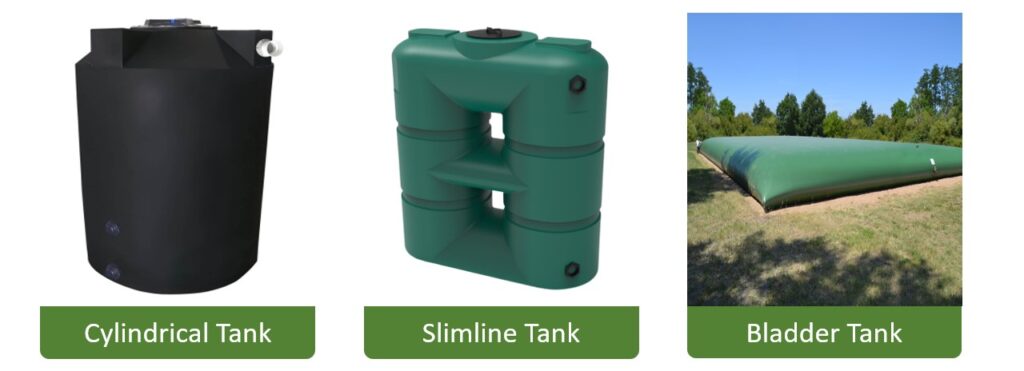
Above Ground Rainwater Tanks Made from Metal
Metal above ground rainwater tanks are available in either galvanized steel or stainless steel. Metal rainwater tank types are most often cylindrical in shape and can be considered more aesthetically appealing. Galvanized steel rain tanks can provide large storage capacities and several distinct features but also need a larger property area and often require professional installation. The most distinct, exclusive feature of a galvanized steel rain tank is an add-on option that allows rainwater to be harvested from the roof of the tank itself.
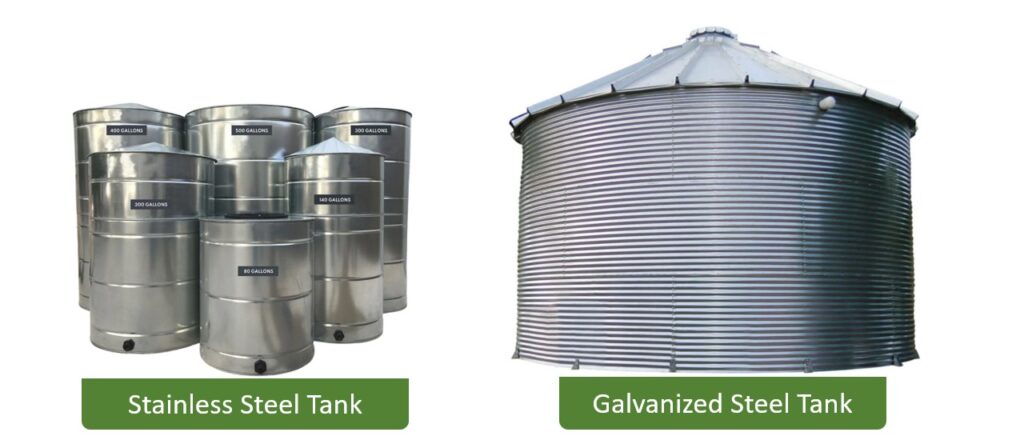
Above Ground Rainwater Tanks Made from Fiberglass
Fiberglass rainwater tanks are typically manufactured on request and are most often chosen for their ability to provide a larger storage capacity with a smaller base area and taller vertical height. Fiberglass rainwater tanks are more frequently used in commercial, industrial, and municipal applications.
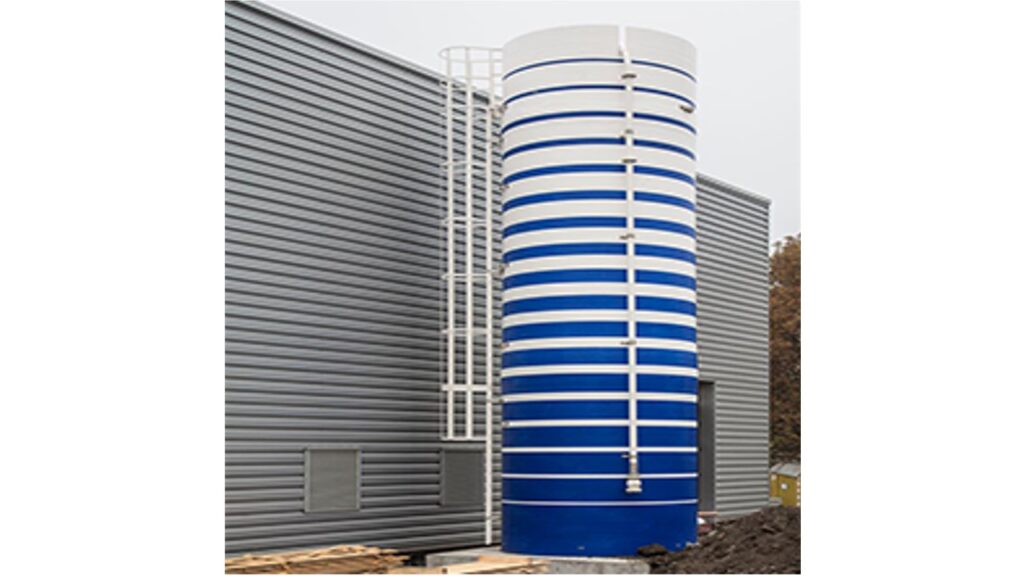
Important Point on Above Ground Rainwater Tanks
An important point on above ground rainwater tank types: above ground storage tanks are built for above ground placement, installation and use only. It is a fairly common question whether above ground tanks can be buried, and the answer is no, they cannot. The tanks are not engineered to withstand the weight and pressures of underground burial and should not be used for this purpose as it may affect tank integrity, service life, and may void any manufacturer’s warranty.
Tank Types: Underground Rainwater Tanks
Compared to above ground tanks, there are fewer tank types available as an option for underground rainwater tanks. Polyethylene plastic is the most common material used to make underground rainwater tanks, and most you will find listed for sale online are made from polyethylene. Fiberglass and concrete material tanks can be installed underground and used for rainwater harvesting but are less common, tend to be more expensive, and can be more difficult to handle and install.
Polyethylene underground rainwater tanks are sometimes referred to as cisterns, and are either spherical or flat-bottomed, dome-shaped containers. They are specifically engineered for burial and usually built with structural ridges that improve the tank’s strength to help withstand the rigors of underground installation.
Tank risers, also known as manhole extensions, are available for an underground rainwater tank and are used to bring the tank’s manway port to surface level to allow access to the tank interior without having to dig and unearth the tank.
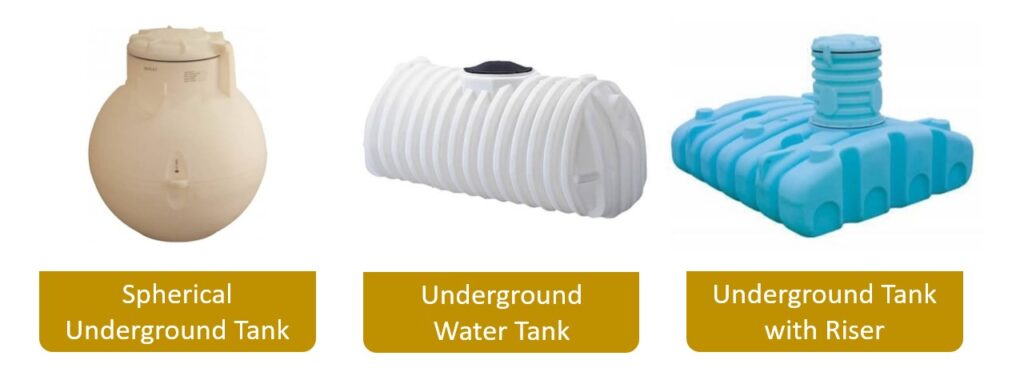
Important Point on Underground Rainwater Tanks
Similar to above ground tanks, an underground tank is built exclusively for its intended installation location and is not recommended for above ground placement and use in water collection, storage, and distribution.
Tank Options
Tank options will be used here to refer to a rainwater tank’s total volume capacity, size measurement, and other tank specific features.
In general, above ground rainwater tanks have an overall wider selection of available storage volumes, different sizes, and feature options compared to underground tanks. This is perhaps due to their popularity as a more common choice as well as due to the different available tank types and manufacturing materials.
Concerning storage volume, cylindrical above ground polyethylene rainwater collection tanks often range in capacity from 100 gallons up to 10,000 gallons, with standard water tanks up to 20,000 gallons. Slimline rain tanks are traditionally smaller with volumes ranging from 100 gallons to 1,000 gallons. Polyethylene bladder tanks can range up to 100,000 gallons of storage or more.
For metal rain tanks, stainless steel tanks often have a lower volume range due to the cost and workability of the material: often maxing out around 10,000 gallons. Galvanized steel rain tanks are frequently chosen when large storage volumes are needed with capacities common between 20,000 gallons to 100,000 gallons and more.
For polyethylene underground rainwater tanks, total volume capacity often ranges from 250 gallons to 20,000 gallons.
Table of Above Ground and Underground Tank Storage Sizes
Below is a table of commonly available storage volume sizes for both above ground and underground polyethylene water tanks.
| Above Ground Tanks | Underground Tanks |
|---|---|
| 100 Gallons | 250 Gallons |
| 125 Gallons | 325 Gallons |
| 130 Gallons | 525 Gallons |
| 150 Gallons | 550 Gallons |
| 200 Gallons | 575 Gallons |
| 250 Gallons | 600 Gallons |
| 265 Gallons | 825 Gallons |
| 420 Gallons | 850 Gallons |
| 500 Gallons | 1000 Gallons |
| 530 Gallons | 1150 Gallons |
| 660 Gallons | 1175 Gallons |
| 730 Gallons | 1200 Gallons |
| 865 Gallons | 1400 Gallons |
| 1000 Gallons | 1425 Gallons |
| 1110 Gallons | 1450 Gallons |
| 1320 Gallons | 1500 Gallons |
| 1500 Gallons | 1700 Gallons |
| 2500 Gallons | 1725 Gallons |
| 2650 Gallons | 1750 Gallons |
| 2825 Gallons | 2000 Gallons |
| 3000 Gallons | 2500 Gallons |
| 4050 Gallons | 2600 Gallons |
| 4995 Gallons | 2650 Gallons |
| 5000 Gallons | 3525 Gallons |
| 10000 Gallons | 5025 Gallons |
| 12500 Gallons | 10000 Gallons |
| 15000 Gallons | 15000 Gallons |
| 20000 Gallons | 20000 Gallons |
Benefits of an Above Ground Tank
The primary benefit of an above ground rainwater tank is ease of access. By being easier to access compared to an underground tank, an above ground tank is easier to:
- Initially set up and install for use
- Access collected water
- Make and modify connections to inflow and outflow plumbing
- Fix problems that may arise such as leaks at fittings or in pipes
- Perform maintenance such as tank cleaning or draining
- Perform inspections on current water quality, levels, and buildup of any sediment, debris or algae
- Upgrade by replacing the tank for one with a larger volume
- Add on additional tank(s) or equipment
- Relocate if ever necessary
An additional point which may be considered as a benefit, above ground rainwater tanks do not require a water pump for many common, outdoor, low flow, low pressure use applications. An underground tank system on the other hand will require a water pump in every setup to allow the water to be withdrawn.
Benefits of an Underground Tank
The top benefits of an underground rainwater tank are stability and security. Stability in terms of water quality and security in terms of tank safety. Compared to an above ground tank, an underground tank provides:
- Protection from growth of algae since underground installation blocks sunlight
- Near-consistent water temperature as tank burial prevents sunlight warming and ambient temperature effects
- Winter freeze protection due to burial depth and natural warmth of the earth’s soil
- The ability to save valuable above ground land space
- Complete protection from pests and animal access
- Reliable, increased water flow rate and pressure due to a required water pump
- Protection from accidental damage
On the point of accidental damage, an underground rainwater tank is protected from some damage that can affect the structural integrity or permanently render an above ground tank unfit for use. Examples of accidental damage to a rainwater tank that underground tanks are protected from include direct vehicle impacts, falling objects from storms or rare events such as trees, large branches or property structures, and disasters such as tornadoes and wildfires.
Disadvantages to Above Ground Tanks
The foremost disadvantage to a polyethylene above ground rainwater tank is the concern for algal growth. However, algae can be largely, if not entirely, prevented by choosing a premium manufactured, dark colored rain tank that is kept closed, directly plumbed or uses a tank screen cover, and is installed in a location that limits direct sunlight, such as on the north side of a building.
Additional points of concern for an above ground rainwater tank are from accidental damage and freezing. The tank’s above ground installation will make it susceptible to any potential large object falling on it due to a storm, direct vehicle impact, fire damage, or other natural disaster event.
Concerning water freezing in a storage tank, an outdoor above ground tank will be susceptible to ambient temperature changes and conditions, unlike an underground tank. If local temperatures drop below the 32°F (0°C) freezing point for a sufficient length of time, then water in the tank turning to ice becomes a concern. How fast this happens will depend on the total volume of water, (more water, longer to freeze), how cold, (lower temps, faster freezing), and anything working to protect the tank from freezing such as a temporary shelter, insulation or aeration.

If water freezes in a tank, the process can potentially damage fixtures and plumbing connections on the tank due to the expansion of water as it turns to ice. See our Rain Tanks Series post on how to prevent freezing in an outdoor water tank.
Disadvantages to Underground Tanks
The main disadvantages to an underground tank are associated with the requirements of its installation and accessibility to the tank and fixtures after being installed. An underground rainwater tank must often be professionally installed by a licensed contractor. This is due to specifics based on manufacturer requirements, regional soil conditions and any local regulations. Placement of plumbing connections should be done during installation. After installation, the tank must be unearthed for any modifications, repairs or replacements to fixtures or pipes.
A noteworthy point is the requirement for a water pump to be set up, used, and maintained for an underground tank. A water pump will be necessary to withdraw the water from the underground tank against gravity regardless of the application. While the inclusion of a water pump will provide the benefit of greater flow rates and pressures, it is also an additional cost in system preparation and will require a power source.
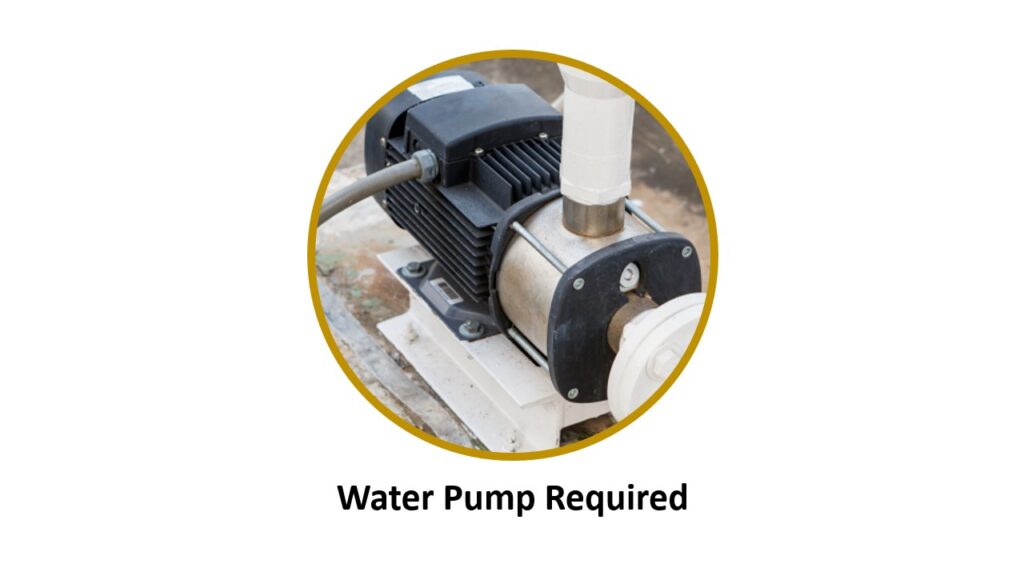
Similar to a septic tank, an underground rainwater tank can be damaged by vehicles or heavy machinery that drive over where the tank is buried. While this can be easily avoided, it does hold the possibility for an accident to occur and restricts traffic from that area of the property.

Due to the underground installation and design, an underground rainwater tank cannot be used with the tank screen accessory commonly used in rainwater harvesting systems. All other pre-tank filtration and rain harvesting accessories can be used and must be installed in the system before the tank.
Takeaway | Above Ground vs Underground Rainwater Tanks
There are advantages and disadvantages to each tank type, mainly due to where a rainwater tank is installed: either above ground or underground. Concerning tank features and available products, above ground rainwater tanks have a wider selection of tank types, construction materials, and storage volumes. On the other hand, underground rainwater tanks provide unparalleled water stability and tank security yet require a water pump and a more work-intensive and detailed installation. An above ground rainwater tank is overall easier to set up, manage, and use, yet has concerns for algae and physical damage from accidents or unforeseen events.
It is our hope that this Rain Tanks Series post has provided information that has been helpful in planning for a rainwater harvesting system by comparing above ground versus underground rainwater tanks. If you need any help in selecting the right rainwater tank and accessories or have further questions, contact our professional support staff or send us a message, we will be glad to help.